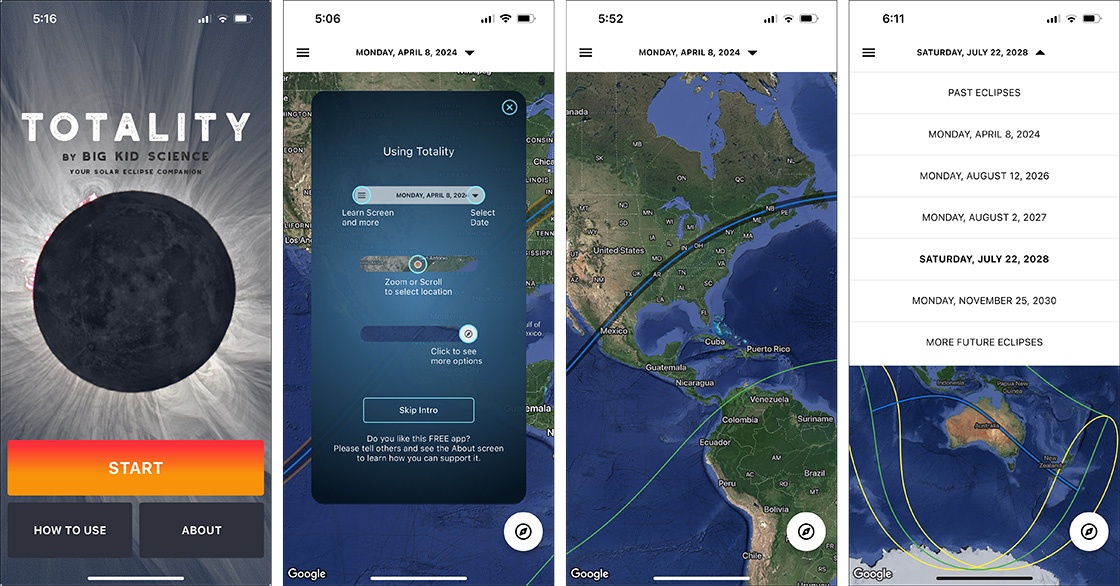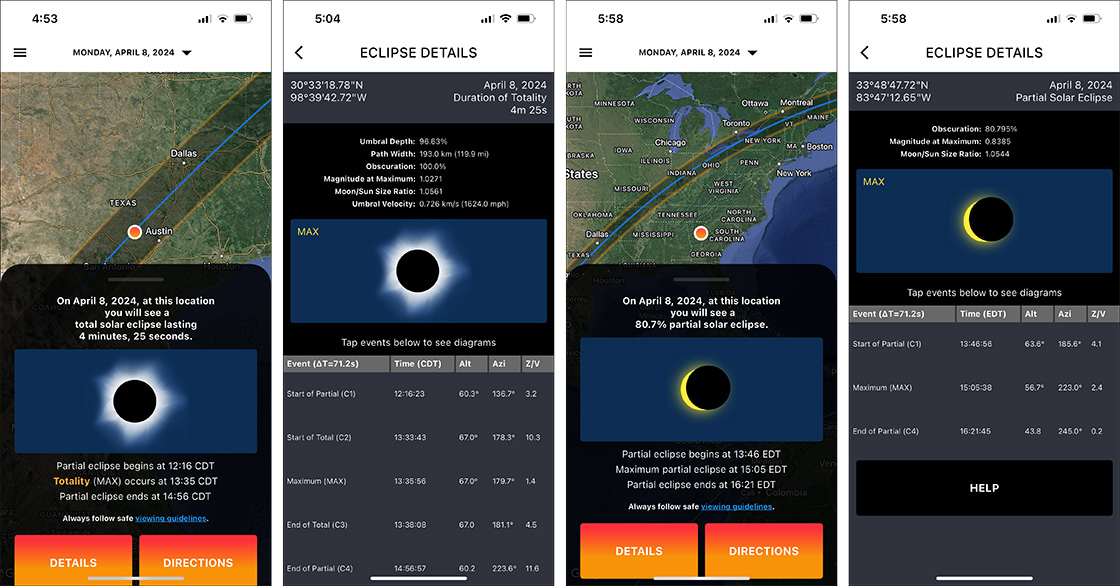AAS & Big Kid Science Unveil Totality 4.0
Just in time for the April 8th Great North American total solar eclipse, the American Astronomical Society (AAS) and Big Kid Science have released version 4.0 of the Totality app, available free for iOS and Android smartphones. Totality, your solar eclipse companion, puts recent and upcoming total solar eclipses in your pocket and includes the following features, among others:
- An interactive map that shows what you’ll see at any location in North America for the total solar eclipse of April 2024, with the ability to zoom, scroll, and tap to move around the map, get a table of eclipse circumstances at any location, and bring up additional details.
- Interactive maps of recent (since 2017) and upcoming (through 2030) total solar eclipses worldwide. All maps are based on code by renowned eclipse expert Xavier Jubier.
- Custom information (using your phone’s GPS) about what you can see at your current location, the nearest location where you can witness totality and, where possible, driving directions to the eclipse’s central line.
- Information on how, when, and why eclipses occur, as well as how to observe them safely.
And it’s all free — with no ads — created as a public service by Big Kid Science and sponsored by the AAS.

The new and improved version 4.0 of Totality is available for iOS and Android devices in English, Spanish, French, and Portuguese. (The appropriate language appears automatically based on your device’s language setting.) This update was funded by a grant to the AAS Solar Eclipse Task Force from the American Institute of Physics (AIP) Venture Fund.
Get Totality for iOS Get Totality for Android

To learn more, see the app’s page at Big Kid Science. For links to more eclipse-related smartphone apps, programs for desktop and laptop computers, and other useful resources, see the Apps & Software page on the website of the AAS Solar Eclipse Task Force.
Contacts
Images
https://aas.org/sites/default/files/2024-03/Totality_v4_Screens.png
Left: The Totality app's splash screen. Center-left: Pull up this handy tutorial at any time from the main menu. Center-right: Map of the April 8, 2024, total solar eclipse across North America. The green line shows the southern limit of the partial eclipse. Right: Easily access interactive maps of future eclipses through 2030. Courtesy Big Kid Science & American Astronomical Society.
https://aas.org/sites/default/files/2024-03/Totality_v4_Circumstances.png
Left: Tap a spot in the path of totality to pull up a summary of the total eclipse at that position. Center-left: After tapping the DETAILS button, you get detailed eclipse circumstances there. Center-right: Tap a spot outside the path to pull up a summary of the partial eclipse at that position. Right: After tapping the DETAILS button, you get detailed eclipse circumstances there. The images show approximately what you'll see at maximum eclipse at the location you've specified. Courtesy Big Kid Science & American Astronomical Society.
About the AAS
The American Astronomical Society (AAS), established in 1899, is a major international organization of professional astronomers, astronomy educators, and amateur astronomers. Its membership of approximately 8,000 also includes physicists, geologists, engineers, and others whose interests lie within the broad spectrum of subjects now comprising the astronomical sciences. The mission of the AAS is to enhance and share humanity’s scientific understanding of the universe as a diverse and inclusive astronomical community, which it achieves through publishing, meetings, science advocacy, education and outreach, and training and professional development.
About Big Kid Science
Big Kid Science is your source for fun and scientifically accurate products to educate and inspire. Founded in 2003 by astronomer, teacher, and writer Jeffrey Bennett, Big Kid Science publishes award-winning books for teachers, students, and the public as well as learning activities and resources for children, families, and classroom instructors. The company devotes 100% of its revenue (not only its profits) to a combination of nonprofit donations and free public outreach, including the development of the Totality app.



